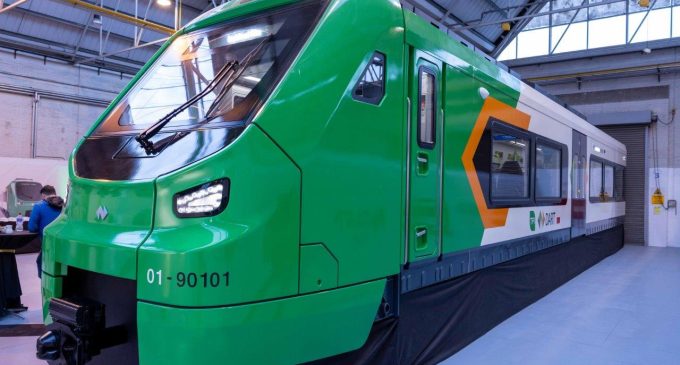Irish Rail’s ‘transformative’ decarbonisation push gathers steam

National railway operator Iarnród Éireann-Irish Rail (IE) has released tenders that underline its central role in the decarbonisation of Ireland’s infrastructure, writes David Keniry.
Irish Rail has issued a Pre-Qualification Questionnaire (PQQ) for a multi-party framework for business case and transport planning advisory services with responses due in February. The PQQ proposes to establish a multi-party framework comprising of three multi-disciplinary consultants, to provide transport planning and economic advisory services across all phases of the project lifecycle as set out in the Transport Appraisal Framework and the National Transport Authority project lifecycle.
The indicative scope of services includes:
- Development of business cases to support rail and public transport proposals;
- Analysis and provision of commercial advice in relation to the funding of rail and public transport proposals;
- Research how transport is provided in other jurisdictions and the economics of service delivery and related matters;
- Economic impact analysis of changes in public transport policies;
- Economic/financial and/or commercial analysis in relation to transport competition and State Aid issues
A PQQ was issued last week for the supply of Hydrotreated Vegetable Oil (HVO) for a trial on passenger services between Cork and Dublin. Additionally, IE will require technical support during the supply contract including engineering analysis and reporting to assist Iarnród Éireann’s business case for the ongoing use of HVO. Responses are due by February 11th for the HVO tender which is part of Irish Rail’s drive to decarbonise its operations.
IE also requires the services of a single competent contractor for the design, installation and maintenance of solar PV systems at fleet maintenance depots, rail stations, and infrastructure buildings nationwide. An initial competition for the supply, installation, commissioning and maintenance of Solar PV systems at fleet maintenance depots in Drogheda, Inchicore and Portlaoise will be used to establish the Framework Agreement. Responses are due on February 6th.
On January 24th Chief Executive Jim Meade told the Oireachtas Joint Committee on Transport and Communications that IE’s climate action to reduce emissions by 51% by 2030 will be achieved from reduced reliance on diesel through alternative fuels on existing fleets with biofuels, hydrotreated vegetable oil, HVO, and green hydrogen programmes being pursued and track maintenance vehicle and road fleet transition programmes under way.
IE are also transitioning to electric-powered fleet. The DART+ fleet are the first order from a framework contract of 750 carriages, which can also serve the Cork area, Wicklow and elsewhere, subject to infrastructure investment.
“We will also achieve reduced emissions through: green energy generation, including photovoltaic, PV, solar panels and corporate purchasing power agreements; a fleet and building works to reduce energy consumption, with our existing intercity railcar and commuter fleets seeing hybrid power and other upgrades to reduce consumption; and building upgrades to improve energy efficiency while protecting the heritage of our buildings,” Meade added.
Meade accompanied by Paul Hendrick, director of capital investments, and Barry Kenny, corporate communications manager provided a comprehensive update to the committee on activities, including capital projects and operations across the network.
Meade opened the debate stating that: “We are at a time of great ambition and optimism for our rail services and network, and for Rosslare Europort, for which Iarnród Éireann is the port authority. Projects for all our cities and for the national network will ensure rail is the backbone of Ireland’s sustainable transport network. The decade of delivery that we are working through will be genuinely transformative for the network.”
He added that IE’s current planned fleet and network investment programme will exceed €1 billion during the life of the National Development Plan (2030) and will bring a new era for rail transport in Ireland.
In addition to the short-term introduction of 41 new intercity railcar carriages, the first of 185 DART+ carriages on order from Alstom will arrive in summer of 2024 to begin testing and commissioning ahead of entering service in 2025.
“These are battery-electric and so are a very sustainable fleet. This transformative fleet is central to the DART+ programme. The investment will allow more trains to operate on all routes on the rail network, provide greater standards of accessibility, and allow for the decarbonising of all greater Dublin area rail services. DART+ will double the capacity and treble the electrification of the greater Dublin rail network,” Meade noted.
IE are also progressing, with Translink, a tender for a new Enterprise fleet, to ensure a sustainably powered hourly service on the Dublin to Belfast route and are liaising with the Department of Transport and Special EU Programmes Body on funding and timelines for this project.
All projects in the Cork area commuter rail programme are under way under the EU-funded Recovery and Resilience Plan, allowing Iarnród Éireann to treble the Cork commuter rail network’s capacity through three enabling projects on the infrastructure side. First is double-tracking Glounthaune to Midleton. The railway order was granted before Christmas and works have commenced.
IE are developing a new platform at Cork’s Kent Station that would allow through-running for Mallow to Cobh-Midleton and are resignalling the Cork commuter network, for which the contract has been signed and work commenced. That whole project is on target for delivery in 2026.
In Galway, funding under the Urban Regeneration Development Fund includes investment of €9.3 million for a second platform and passing loop at the existing Oranmore train station. This will allow the busy commuter link between Athenry and Galway to grow. A planning application is currently in the pipeline for early this year. In addition, Ceannt Station will be regenerated as part of a major Galway City Council transport connectivity project. Physical works began earlier this month, which will deliver a transformative five-platform station at the heart of an integrated transport hub, catering for all future service growth.
Waterford’s Plunkett Station is being relocated to be part of an integrated transport hub under the Waterford North Quays, and these works are also under way.
In Limerick, the completion of the city’s own transport hub centred at Colbert Station will boost services, and the Limerick Shannon metropolitan area transport strategy has detailed the opportunities provided by the network of rail lines around Limerick city. Station studies are under way for both Moyross and Ballysimon stations, and a capacity enhancement study for Limerick to Limerick Junction and Limerick to Ennis is also under way. Works to reinstate the Limerick to Foynes rail line for freight services are under way following funding from the Department of Transport with an early 2026 opening still planned.
The Rail Freight 2040 Strategy aims to achieve a fivefold increase in the number of freight services, to include more than 100 new weekly services across the network; a resulting reduction of 25,000 tonnes of CO2 emissions annually, with rail freight emissions per unit as little as 16% of HGV emissions; and avoiding the requirement for 140,000 HGV journeys on our roads annually, as well as helping the supply chain, which is facing a shortage of HGV drivers.
The strategy outlines 25 initiatives and a cumulative investment of approximately €500 million within the five strategic pillars of the freight strategy, which are: enhancing connections with sea ports; developing a network of inland intermodal terminals; investing in new wagon fleets and bimodal locomotives to allow for further decarbonisation of freight flows; network developments including the connectivity of industrial sites directly to the network; and working with national, regional and European agencies to ensure a policy framework is in place to support a more favourable environment for rail freight, in line with European norms.
Iarnród Éireann strongly supports all recommendations in the draft All-Island Strategic Rail Review and look forward to collaborating with all stakeholders on next steps, and see it as part of the real momentum towards rail playing a stronger role in transport and mobility solutions over the years and decades ahead.
“It is critical that we ensure a steady pipeline of projects to maintain our infrastructure development and move away from stop-start patterns of the past.”
As well as investment in the Rosslare Europort Port Masterplan Meade said that “an ambitious €200 million plan to become one of Ireland’s Renewable Energy Hubs to service the ORE sector is progressing, with the port uniquely placed to support the development of the industry in the Celtic and Irish Seas. The planning process for this key national and regional strategic investment will be progressed throughout 2024. We are also supporting the Office of Public Works in its significant T7 investment programme, incorporating permanent Border Control facilities within our site at Rosslare Europort.”
Concluding his presentation Meade noted that IE has “been awarded Apprenticeship Employer of the Year, with a commitment not only to excellent apprenticeships, but continued career opportunities. It is a busy time, but an exciting one, and our team of over 4,500 colleagues across all business areas are working as one team to deliver on our ambitions.”
Irish Rail is at the intersection of Ireland’s infrastructure, energy, economic, housing, and climate challenges and is leading from the front to find solutions, their enterprise deserves strong support from stakeholders.








